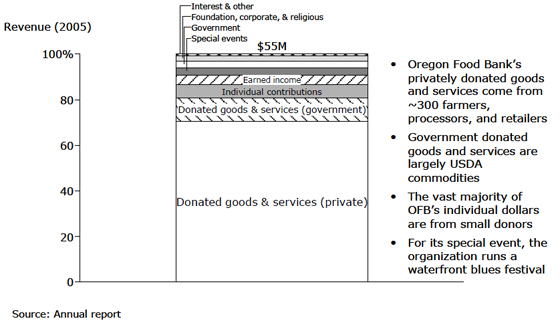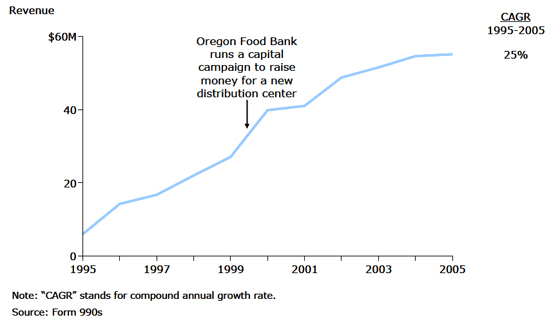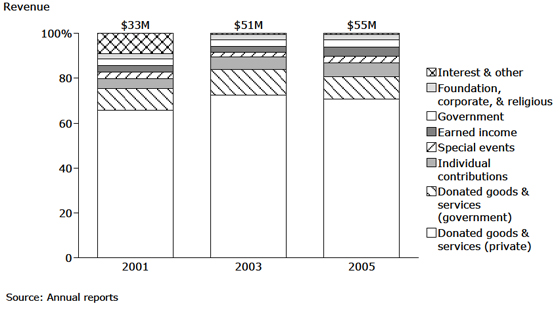Nurture your volunteers and build your individual donor base.
– Rachel Bristol, Executive Director
Overview
Related Content
How Nonprofits Get Really BigOrganization Profiles from How Nonprofits Get Really Big
Since 1982 Oregon Food Bank has worked, “to eliminate hunger and its root causes…because no one should be hungry.” The organization is the hub of a statewide network of 894 hunger-relief agencies. This network serves all of Oregon as well as Washington’s Clark County. In 2005, the Oregon Food Bank collected and distributed 38.1 million pounds of food. OFB also works to eliminate the root causes of hunger through advocacy, nutrition education, learning gardens, and public education.
Oregon Food Bank recovers food from farmers, manufacturers, wholesalers, retailers, individuals, and government sources. The organization also raises funds from individuals (primarily small donors) and a waterfront blues festival.
OFB distributes food to 20 regional food banks across Oregon. Sixteen are independent charitable organizations. OFB directly operates the four regional food banks serving the Portland metro area, southeast Oregon and Tillamook County, OR. Those four centers distribute food weekly to more than 360 food pantries, soup kitchens, shelters and other programs helping low-income individuals in Clackamas, Clark, Multnomah, Washington, Tillamook, Malheur, and Harney counties.
Founding date: 1982
Revenue (2005): $55 million
Structure: Single organization
NCCS classification: Food, agriculture & nutrition—food banks & pantries
Services: Provides food to the hungry through its own locations and through a network of organizational partners
Beneficiaries: Lower-income residents of Oregon and Clark County, Washington
Leadership (selected): Rachel Bristol, Executive Director
Address: P.O. Box 55370, Portland, OR 97238-5370 (mailing); 7900 N.E. 33rd Drive, Portland, OR
Website: www.oregonfoodbank.org

Growth Story
- 1982 – The Oregon Food Share (OFS) is founded.
- Early 1980s – Oregon suffers major losses in the food and timber industries. The federal government begins to distribute free cheese and other commodities to states to deplete huge stockpiles and help the poor. Oregon State contracts with Oregon Food Share to distribute commodities through its newly formed statewide food bank network, the first statewide system of its kind in the U.S.
- 1988 – OFS merges with Interagency Food Bank to become Oregon Food Bank, serving the Portland Metro area and agencies statewide. Rapid declines in USDA commodities trigger a renewed focus on developing private food donations.
- 1999 – The USDA releases a study citing Oregon as the worst state in terms of hunger and food security. OFB runs a capital campaign to build a new distribution center.
- 2000 – OFB expands efforts in building its fresh and frozen food donations and distribution capabilities.
- 2002 – OFB settles into a specially designed 108,000 square foot facility, allowing it to quadruple its number of volunteers and to double the volume of food processed and distributed annually by 2005.
Revenue Trends
Revenue growth: Top line revenues have grown steadily.

Funding mix: OFB’s general mix of in-kind versus cash donations has remained constant in recent years, but within each category constant innovation and capacity development has been required to sustain growth.

Actions That Helped Propel Growth in Funding
- Continually deepened its core operational capabilities. OFB’s operational capabilities have helped it to survive and expand. For example, fresh and frozen food donations have grown markedly recently. In response, OFB has become a national leader in the logistically-demanding handling of fresh and frozen foods.
- Was enterprising in developing funding within established sources. In OFB’s early years, 75% of its donations came from USDA. From 1988 to 1990, OFB shifted to 75% private donations. In the late 1990’s, it shifted from large donations of packaged and canned goods from a few retailers to large quantities of bulk fresh and frozen donations from farmers and processors. Early in 2000, OFB developed new partnerships with retailers to recover perishable items at individual stores daily.
- Tapped into broader social trends and concerns. OFB expanded in the 1980’s as the government cut back social support programs. It gained community support in 1999 when the USDA ranked Oregon last in food security and hunger.
- Used a wide range of cash funding sources. While over 80% of the organization’s support comes from in-kind donations, OFB uses a variety of sources to meet its cash needs.
- Built a strong management team. Throughout its history several key executives and board members have enabled OFB to reach its next level of development including its board, capital campaign committee, executive director, business director, and development director.
Funding Challenges
- Funding advocacy efforts. Getting involved with advocacy efforts brings the risk of hurting relationships with donors. OFB has chosen, however, to pursue some aggressive advocacy work.
- Building cash reserves and capacity. Cash reserves, endowment growth and investments in capacity building have become more significant over time but are still difficult for OFB to secure.

